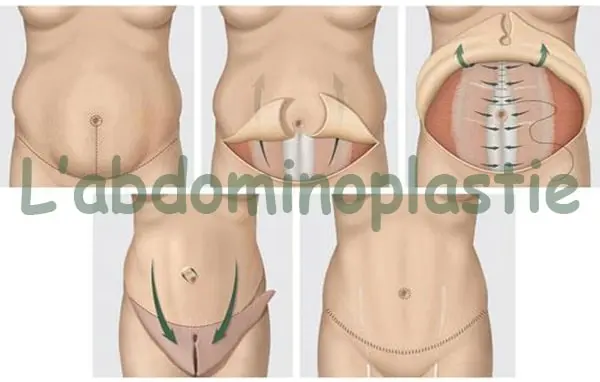Abdominoplasty: When and For Whom?
Abdominoplasty, commonly known as a tummy tuck, is a surgical procedure designed to reshape and tighten the abdominal area. It's often chosen by individuals seeking a flatter, more toned stomach, especially after significant weight loss or pregnancy.
Two main abdominoplasty techniques exist: simple abdominoplasty (mini-tummy tuck) and extended abdominoplasty, which includes umbilical transposition.
The chosen technique depends on factors like skin condition, excess fat, abdominal muscle tone, and patient expectations and goals. Patients collaborate with their plastic surgeon to discuss options and create a personalized plan for safe, effective results.
What is an Abdominoplasty with Umbilical Transposition?
Abdominoplasty with umbilical transposition is a more extensive and complex procedure than a simple tummy tuck. The umbilicus (navel) is repositioned for a harmonious aesthetic outcome.
Surgery involves an incision, usually hip to hip, to access abdominal muscles, excess skin, and fat. Weakened or separated muscles are tightened, creating a firmer abdominal wall. Excess skin is removed, and the remaining skin is redraped for a flatter abdomen.
The umbilicus is repositioned by creating a new opening in the redraped skin, moving, and suturing the navel to its new location, preserving its natural appearance. This results in a flat stomach and well-defined contours.
This procedure is often chosen by patients with significant abdominal skin laxity, usually after pregnancy or significant weight loss. While more invasive with a longer recovery, it offers remarkable body transformation and restored self-confidence.
GET A FREE QUOTE
Would you like more information?
Your health, our priority.
Request your free quote
Who is Abdominoplasty For?
Abdominoplasty primarily benefits individuals with abdominal skin and muscle laxity, often due to pregnancy, significant weight loss, or aging. Ideal candidates are generally healthy, non-smokers, near their ideal weight, but with localized fat or excess skin in the abdominal region.
It's particularly suitable for postpartum women struggling to regain their pre-pregnancy figure despite healthy lifestyles and exercise. It also benefits those who have experienced significant weight loss and have excess skin and fat.
Consultation with a qualified plastic surgeon is crucial to assess eligibility, discuss expectations, and determine if abdominoplasty meets individual aesthetic needs.

What is the Principle of the Surgery?
Abdominoplasty aims to remodel the abdominal region for a flatter, firmer stomach. An incision (usually at the bikini line) allows access to muscles, excess skin, and fat. Weakened or separated muscles are tightened, strengthening the abdominal wall and improving the silhouette. Excess skin and fat are removed, and the remaining skin is redraped for a flatter, more toned abdomen. The principle is to restore abdominal contour harmony by eliminating excess tissue and reshaping for lasting, natural results.
How do Scars Evolve?
Abdominoplasty scars evolve over time, going through several healing phases. Initially (first few months), scars may be red, swollen, and irregular – a natural response to injury. Over months, scars fade and flatten, becoming less visible and closer to natural skin color. Final appearance typically takes about a year, although healing varies. Following post-operative instructions (avoiding sun exposure, using recommended creams) promotes optimal healing. While scars may remain, most patients find the aesthetic benefits outweigh scar concerns.
What Does Post-Operative Care Consist Of?
Post-operative care is crucial for optimal healing and results. Follow your surgeon's instructions, which may include wearing a compression garment, pain medication, and infection prevention. Regularly monitor scars for infection and contact your surgeon immediately with concerns. Limit strenuous activity, maintain a healthy diet, and avoid smoking (it compromises circulation and delays healing).
What are the Post-Operative Recommendations?
Follow your surgeon's instructions meticulously. This includes wearing a compression garment, taking prescribed medication, maintaining a healthy diet, avoiding smoking, limiting strenuous activity, and resting sufficiently. Regularly monitor scars for complications and consult your surgeon promptly if concerns arise. Careful adherence maximizes results.
What are the Possible Complications of Abdominoplasty?
While generally safe and effective, abdominoplasty carries risks. These include infections (requiring antibiotic treatment), scarring problems (hypertrophic or keloid scars needing further treatment), temporary numbness, and rarely, serious complications like blood clots or nerve damage (requiring immediate attention). Discuss risks with your surgeon and follow post-operative instructions to minimize complications. An experienced surgeon and diligent post-operative care improve outcomes.
Is Pregnancy Possible After Abdominoplasty?
Pregnancy after abdominoplasty is possible, but pregnancy can affect the surgical results. Skin and muscles stretch during pregnancy, potentially compromising the aesthetic outcome and increasing stretch mark risk. Ideally, wait to complete childbearing before abdominoplasty. If planning pregnancy afterward, discuss it with your surgeon for personalized advice on managing your situation and maximizing results.